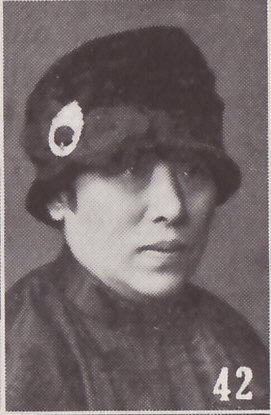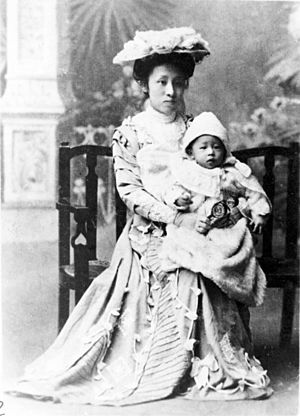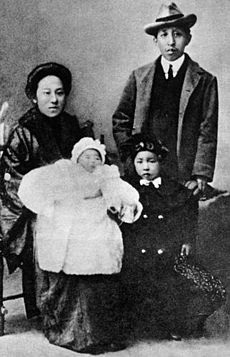He Xiangning facts for kids
Quick facts for kids
He Xiangning
|
|
|---|---|
|
何香凝
|
|

He Xiangning as pictured in The Most Recent Biographies of Chinese Dignitaries
|
|
| Chairperson of Revolutionary Committee of the Chinese Kuomintang | |
| In office 1960–1972 |
|
| Preceded by | Li Jishen |
| Succeeded by | Zhu Yunshan |
| Personal details | |
| Born | 27 June 1878 British Hong Kong |
| Died | 1 September 1972 (aged 94) Beijing |
| Nationality | People's Republic of China |
| Political party | Revolutionary Committee of the Chinese Kuomintang |
| Spouse | Liao Zhongkai |
| Children | Liao Chengzhi |
He Xiangning (Chinese: 何香凝; Wade–Giles: Ho Hsiang-ning; born 27 June 1878 – died 1 September 1972) was an important Chinese leader. She was a revolutionary, a supporter of women's rights, a politician, an artist, and a poet.
She and her husband, Liao Zhongkai, were among the first people to join Sun Yat-sen's revolutionary group called Tongmenghui. This group aimed to change China. As the Minister for Women's Affairs in Sun Yat-sen's government in Guangzhou, she worked hard for equal rights for women. She also organized China's first event for International Women's Day in 1924.
After her husband was killed in 1925, and after Chiang Kai-shek's actions against the Communists in 1927, she stepped away from politics for about 20 years. During this time, she actively helped organize resistance against the Japanese invasion of China.
In 1948, she helped start the Revolutionary Committee of the Chinese Kuomintang. After the People's Republic of China was formed, she held many high-ranking positions. These included Vice Chairwoman of the CPPCC (1954–64) and Vice Chairwoman of the National People's Congress (1959–72). She also led the Revolutionary Committee of the Chinese Kuomintang (1960–72) and was an honorary leader of the All-China Women's Federation.
He Xiangning was also a famous painter of the Lingnan School of Chinese art. She was the head of the China Artists Association in the 1960s. The National He Xiangning Art Museum opened in Shenzhen in 1997, and her paintings have even appeared on Chinese stamps.
Contents
Early Life and Education
He Xiangning was born on 27 June 1878, in British Hong Kong. Her birth name was He Jian. She came from a rich family. Her father, He Binghuan, was a successful businessman from Nanhai, Guangdong Province. He traded tea and invested in land.
He Xiangning was very determined. She convinced her father to let her study with her brothers. She was a very hardworking student from a young age.
Fighting for Women's Rights Early On
Even when she was young, He Xiangning believed strongly in women's rights. She bravely refused to have her feet bound, which was a painful old Chinese custom for women. Because she had "big feet," she was arranged to marry Liao Zhongkai in October 1897. He was an American-born Chinese man who did not want a wife with bound feet.
Even though it was an arranged marriage, He and Liao had a lot in common. They both loved learning and art, and they both cared deeply about saving China. She used her own savings and sold her jewelry to help her husband study in Japan. She raised 3,000 silver dollars for him. Liao went to Japan in November 1902, and she followed him two months later. She studied at a special school for women in Tokyo.
Joining the Revolution
While in Tokyo, He Xiangning and Liao Zhongkai met the famous Chinese revolutionary Sun Yat-sen in 1903. They quickly became some of the first members of Sun's group, the Tongmenghui. This group wanted to overthrow the Qing government. Huang Xing, another revolutionary leader, even taught them how to use guns to prepare for the revolution. He Xiangning rented a house that was secretly used for the Tongmenghui's activities.
After giving birth to her daughter, Liao Mengxing, in Hong Kong, she left her daughter with her family and went back to Tokyo. She studied painting at the Tokyo Women's Arts School. She also helped the Tongmenghui by designing and sewing revolutionary flags and symbols. In 1908, she gave birth to her son, Liao Chengzhi.
She and Liao Zhongkai returned to Hong Kong in 1911, the year of the Xinhai Revolution. This revolution led to the end of the Qing dynasty. In 1913, she met Soong Ching-ling, who would later become Sun Yat-sen's wife. He Xiangning and her husband followed Sun's lead in opposing General Yuan Shikai, who had betrayed the revolution. They were forced to go back to Japan as exiles in 1914.
Working with Sun Yat-sen's Government
In 1916, He Xiangning and her husband moved to Shanghai to continue their revolutionary work. In 1921, Sun Yat-sen set up his new government in Guangdong. He made Liao Zhongkai his finance minister. He Xiangning convinced the leaders of seven naval warships to join Sun's government.
In Guangzhou, she and Soong Ching-ling started a women's group. This group raised money and provided medicine and clothes for soldiers. He Xiangning also sold many of her paintings to help fund the war effort. When General Chen Jiongming rebelled against Sun in 1922, He Xiangning helped Sun reunite with his wife. She also took a big risk to get her husband released after he was captured by the rebels.
In August 1923, she became a member of the Kuomintang (KMT) Central Executive Committee. She was also made the Minister for Women's Affairs in Sun's government. She suggested that women should have "complete equality" in legal, social, economic, and educational rights. On 8 March 1924, she organized China's first rally for International Women's Day. She also opened hospitals and schools for women in Guangzhou.
Later Years and Art
After Sun Yat-sen died in March 1925, different groups within the KMT fought for leadership. Liao Zhongkai, who led the left wing of the party, was killed in Guangzhou in August. He Xiangning was right beside him when it happened.
Chiang Kai-shek eventually became the new leader of the party. He started a military campaign called the Northern Expedition. To support this, He Xiangning organized Red Cross groups made up of working-class women and brought them to Wuhan. However, when Chiang's KMT turned against the Communists in 1927, many of these women were killed.
After this difficult time, she mostly stayed away from party politics for the next 20 years. She moved to Hong Kong and Singapore, and traveled a lot in Europe. She showed her paintings in cities like London, Paris, and Geneva.
Resisting Japanese Invasion
She returned to Shanghai after the Mukden Incident and the Japanese invasion of Manchuria in 1931. She helped create the National Salvation Association to encourage resistance against Japan. She also worked with other important activists like Soong Ching-ling and Luo Shuzhang to train women to support soldiers.
She had to leave Shanghai after it was captured by the Japanese in 1937. She also had to flee Hong Kong after it fell in 1941. She spent several years in Guilin during the rest of the Second Sino-Japanese War.
Founding the People's Republic of China
In 1948, during the Chinese Civil War, He Xiangning, Li Jishen, and other KMT members who disagreed with Chiang Kai-shek's leadership started the Revolutionary Committee of the Chinese Kuomintang. After the Communists won the Civil War and created the People's Republic of China in 1949, she moved to Beijing.
She held many important jobs in the new government. These included Vice Chairwoman of the CPPCC (1954–64) and Vice Chairwoman of the National People's Congress (1959–72). She also led the Revolutionary Committee of the Chinese Kuomintang (1960–72) and was the honorary head of the All-China Women's Federation.
He Xiangning continued to work until she was 80 years old in 1959, and she kept many official positions even after that. She passed away on 1 September 1972, at the age of 94, due to pneumonia. She was buried next to her husband in the Liao Zhongkai Mausoleum in Nanjing.
Her Art and Legacy
He Xiangning was a very famous painter of the Lingnan School of Chinese art. In July 1960, she was chosen as the third chairperson of the China Artists Association. She especially loved to paint plum blossoms, pine trees, tigers, and lions. A collection of her paintings was published in 1979.
On 18 April 1997, the He Xiangning Art Museum opened in Shenzhen. This was China's first national art museum named after a single artist. Jiang Zemin, the leader of the Communist Party, wrote the special calligraphy for the museum's name. In June 1998, China Post released a set of three stamps that featured her beautiful paintings.
Images for kids
Family Life
He Xiangning and Liao Zhongkai had two children. Their daughter, Liao Mengxing, became a well-known translator. She was very good at Japanese, English, and French. Their son, Liao Chengzhi, was an important political leader. He was a member of the Politburo and a Vice Chairperson of the National People's Congress. He was even chosen to be China's vice president before he died suddenly in 1983. Liao Chengzhi's son, Liao Hui, also became a significant politician.
See also
 In Spanish: He Xiangning para niños
In Spanish: He Xiangning para niños






